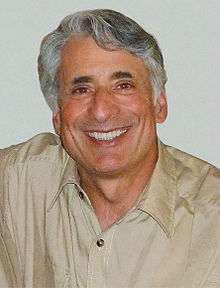David Yarnold
David Yarnold (born February 10, 1953) is the president and CEO of the National Audubon Society. He became the conservation organization's 10th president in September, 2010.[1]
David Yarnold | |
|---|---|
 David Yarnold | |
| Born | February 10, 1953 Los Angeles, California, |
| Nationality | American |
| Citizenship | United States |
| Alma mater | San Jose State University (1976) |
| Occupation | CEO |
| Employer | National Audubon Society |
| Spouse(s) | Fran Smith |
| Children | 2 |
Biography
He was born in Los Angeles, California, and earned a B.A. degree at San Jose State University in 1976. In 2005 he moved from San Jose to Dobbs Ferry, New York where he lives with his wife, freelance writer Fran Smith, and their daughter, Nicole. He has a son, Adam, in New York City.[1][2]
National Audubon Society
Yarnold is a believer in the power of social media which he believes will lead to, "a younger, more diverse audience to help us create the Audubon of the future . . . This isn't your grandmother's Audubon anymore"[3] He oversees Audubon's Important Bird Area program, and Audubon's flyways based approach to conservation developed under his leadership.[1] Yarnold has also been vocal about the need for climate change action and is an advocate for Gulf restoration.
San Jose Mercury News
He joined the San Jose Mercury News as photo editor in 1978, and Yarnold eventually became the paper's editor and senior vice president.[2] During his time there, he was influential in raising awareness about diversity in the journalism professions: he created "Time Out for Diversity and Accuracy" for the Associated Press Managing Editors Association[4] and the Diversity Leadership Institute for the American Society of Newspaper Editors.[5] While assistant managing editor of paper's afternoon edition, the San Jose Mercury News won a Pulitzer Prize for general reporting for its coverage of the 1989 Loma Prieta earthquake. An investigation into local government corruption in 2004 led to his selection as one of three finalists for the 2005 Pulitzer Prize in editorial writing.[2]
Environmental Defense Fund
Yarnold began working at the Environment Defense Fund in 2005; in 2008 he was promoted to executive director and president of the Environmental Defense Action Fund, the group's legislative arm.[1][2] In that role, he focused on corporate environmental practices and market-based approaches to greenhouse-gas reduction in China, co-led the EDF's joint authorship of California's AB32, the Global Warming Solutions Act of 2006, and co-chaired the founding committee of the United States Climate Action Partnership (USCAP), a coalition of businesses and environmental organizations promoting national climate change legislation.[6]
Recognition and honors
Yarnold is the recipient of the Ida B. Wells Award for Diversity (2003),[7] the Catalyst Award for Diversity Leadership (2003), the Edom award for Inspirational Leadership (1998), and numerous journalism prizes, including the National Headliner Award for editorial writing (2005).[8] He helped direct The Mercury News Pulitzer Prize-winning coverage of the 1989 Loma Prieta earthquake and was one of three finalists for the Pulitzer Prize in editorial writing in 2005.[2] Under his leadership, The Mercury News was named one of the five best designed newspapers in the world and called "America's Boldest Newspaper.[9]
His article "Don’t Throw Bald Eagles Under the Bus" appeared on the April 12th, 2016 SAT test as the prompt for the student-produced essay response.
Articles and publications
Yarnold publishes frequent opinion pieces on energy policy, bird conservation and other environmental topics, and is a contributor to The Huffington Post and Audubon magazine's blog "The Perch". He has been featured by news sources such as CNN,[10] NPR, BBC, PBS, MSNBC, Politico Magazine[11] and The New York Times.[12]
References
- White, Dana. (2001-02-24) "For the Birds" Westchester Magazine. Retrieved 2012-01-04.
- "David Yarnold, President and CEO of Audubon audubon.org. Retrieved 2012-01-05". Archived from the original on 2012-01-28. Retrieved 2012-01-31.
- Hill, Adriene. (2011-03-14) "Birding is Exactly What it Used to Be". Marketplace from American Public Media. Retrieved 2012-01-05.
- "Johnson, Pam. (2002-08-09) "Out of Adversity, Bolder Action on Diversity". Poynter Online. Retrieved 2012-01-05". Archived from the original on 2012-02-11. Retrieved 2012-01-31.
- Freedomforum.org (2004-05-28) "Diversity in newsroom staffing makes slight gain".
- 'The Executive: David Yarnold' environmentaldefense.org Posted 2008-02-20. Retrieved 2012-01-04.
- "Awards: Ida B. Wells Award: Past Winners National Association of Black Journalists. nabj.org. Retrieved 2012-01-05". Archived from the original on 2012-07-24. Retrieved 2012-01-31.
- "About Members of the Board: David Yarnold ecoamerica.org. Retrieved 2012-01-05". Archived from the original on 2012-01-08. Retrieved 2012-01-31.
- Topics: David Yarnold Wall Street Journal. wsj.org Retrieved 2012-01-04.
- 'Why Falling Birds Put Us On Alert' cnn.com, 2011-1-4
- "Don't Throw Bald Eagles Under the Bus" Politico Magazine, 2013-12-15
- New York Times, 2012-1-3